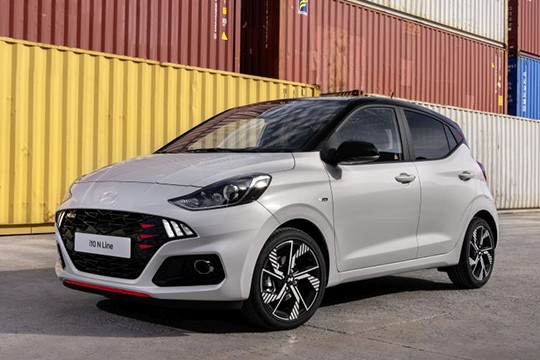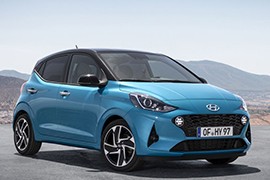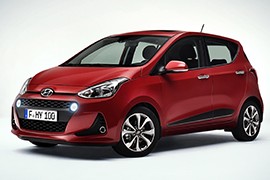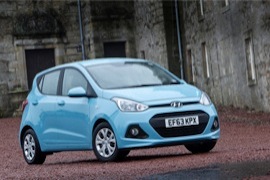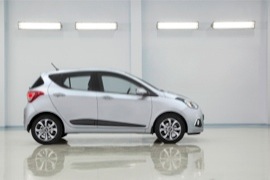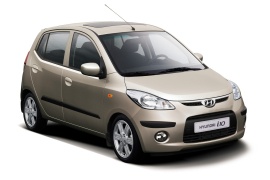HYUNDAI i10 Models/Series Timeline, Specifications & Photos
First production year: 2008
Engines: Gasoline, Natural gas, Diesel
Body style: Hatchback
Hyundai introduced the third generation of its i10 city car in 2019, and four years later, it announced the facelifted version for it at the beginning of March 2023.
The smallest member of Hyundai's family is the i10. This small city vehicle is based on the same platform as the Kia Picanto and tries to get a slice of the segment competing against French and Italian cars in Europe and against Japanese brands in India and Asia. So, to keep it fresh in front of its customers, the Korean automaker improved the pocket-sized hatchback and even gave it an N Line, which was inspired by the performance N-badged Hyundais.
On the front fascia, the 2023 i10 sported a new grille that incorporated the LED daytime running lights, with three oblique lines for the N Line and four horizontal blocks for the rest of the range. Furthermore, the bumper looked different between these two siblings, with the sportier one featuring a broad grille extended to the lower lip spoiler flanked by horizontal scoops, while regular i10s had fake vertical vents that hosted the fog lamps.
The interior of the facelifted version of the Hyundai's small-sized vehicle featured a wide, dual-screen display on the dashboard, with a touchscreen atop the center stack for the infotainment system and a TFT for the instrument panel. There was new fabric upholstery on the refreshed i10, depending on the trim level. Like its predecessor, the 2023 version offered enough room for four adults and a small trunk behind the flat-folding rear bench seat.
The second generation of the Hyundai i10 was revealed before the 2019 Frankfurt Motor Show. While the first generation lacked some equipment and amenities even for a car from its segment, the second generation came to fix that.
The super-mini car segment in Europe was important especially in crowded cities and traffic jams that often led to grid-locks. Considering this, there was a real need for vehicles that could offer a small fuel consumption, enough comfort, and a small price.
The Hyundai i10 was an important vehicle for the Korean brand since it was on top of their sales in Europe. The 2019 model was designed, developed and made in Europe. The front aggressive look of the car was complemented with newly designed light-alloy-wheels, which were offered as an option. Some interesting details could be noticed in the rear side of the car, on the C-pillars where the i10 logo was embossed on the outer plastic trim. The same i10 was visible on the taillights, like the one found on premium vehicles. In the back, depending on the options, there was a splitter and no visible exhaust pipe.
Since the wheelbases have been extended when compared with its predecessor, the 2019 i10 offered more room inside. It also featured more amenities such as an 8” infotainment display with a navigation system, that was offered as an option, automatic climate control, heated seats and steering wheel.
For the drivetrain there were two choices: a 1.0-liter and a 1.2-liter engine. The former was available also in a turbocharged version. The standard transmission was a 5-speed manual, but a 5-speed automatic was available.
Hyundai refreshed the second generation of the i10 in 2016 for the 2017 model year, bringing several upgrades to the smallest member of the Korean automaker’s family.
After almost three years on the market, since Hyundai introduced the i10’s second generation, the Korean automaker considered it time for a refresh. The A-segment vehicle shared its platform with the Kia Picanto, allowing the automaker to lower production costs. Unlike its sibling, the i10 was more upscale, sporting higher-quality materials and richer features. On the technical side, the automaker didn’t make visible progress and continued to provide the vehicle with just two engine options, capable enough to carry four people inside i10’s in and around town. Still, it improved the safety systems.
Hyundai refreshed the exterior and sported the carmaker’s new Cascading grille. As a result, the i10 featured round LED daytime running lights that flanked it for the Premium and Premium SE trim levels. The fog lamps were now smaller and kept their position in the side scoops mounted on the lower side of the bumper. However, they were smaller in diameter than those fitted on the non-facelifted version. The base model came with 13” steel wheels and 14” steelies from the following two grades, S and SE. At the same time, the Premium and Premium SE grades featured 14” and 15” alloy wheels, respectively. Hyundai’s designers added a few final touches on the car’s back, where they prepared a new bumper with black molding and round fog lamps.
Starting with the facelifted version, the i10 became richer in terms of interior equipment. Just like its predecessor, it featured standard central locking and front power windows for the base model. From the SE trim level, customers could order the i10 with red or blue upholstery at no extra cost instead of the regular, black one fitted as standard. The Premium SE came with a seven-year free subscription and live updates, including weather information and real-time traffic. It was the only vehicle in the A-segment to offer such amenities. In addition, the new infotainment system supported Apple CarPlay and Android Auto. Hyundai also tried to make its cars safer, so customers could order the i10 with a Lane Departure Warning System (LDWS) and a Front-Collision Warning System thanks to the new cameras installed on the windshield. The i10 featured the same flat, high-mounted front seats with a split-folding bench seat in the back.
Under the hood, Hyundai kept the inline-three, one-liter gasoline engine for the base model, while the 1.25-liter, inline-four unit was available from the second grade. Thus, the i10 could get excellent fuel efficiency, especially in urban environments. Power went to the front wheels via a standard five-speed manual, and the four-pot powerplant was also available with a four-speed automatic.
At the 2013 Frankfurt Motor Show, the second generation of the i10 debuted on the world scene in Hyundai's booth.
Following the same recipe as its predecessor, the second generation of the i10 was built on top of the Kia Picanto's platform. In fact, the Korean automaker used the Picanto as a test mule in India to test various components for the new vehicle, away from the eyes of automotive spies. And the result exceeded expectations since the small-sized vehicle could squeeze up to five adults inside.
Thomas Burkle was responsible for the car's look, as he was for the previous generation of the i10. Only this time, he dared more and created feline-like headlights. Between them, the automaker installed a slim air intake and left some room in the lower bumper for a larger grille that helped to cool the engine. The arched roof line was abruptly cut at the back by the tilted-forward tailgate, which sported the rear windscreen and a small roof spoiler. The taillights protruded into the tailgate area, emerging from the rear quarter panels.
Inside, the automaker installed high-mounted bucket seats at the front and a 60/40 split-folding bench in the back. Despite using hard plastic materials for the dashboard and door cards, the overall look was better than other cars from the segment. Still, the trunk was good enough just to carry a briefcase and a sandwich, although it could have been expanded by lowering the bench's seatback. But unlike most of the cars in that segment, the i10 offered unusual options such as a heated steering wheel.
The automaker offered the car with manual or automatic transmissions and a choice of two engines of 1.0 or 1.2-liter displacement.
Facing stiff competition against other local carmakers, such as the Maruti Suzuki and Tata Motors, the Korean carmaker had to adapt and improve the i10. It added 40 mm (1.6") to the wheelbase and used them to increase the interior space for the rear passengers.
The car's front fascia was identical to the Indian version of the i10. It featured a hexagonal-shaped grille in the bumper flanked on the sides by two side scoops, where the carmaker offered a pair of fog lights as an option. Its swept-back headlights sported a clear lens for the turn signals and orange bulbs. From its sides, the sculptured door panels were adorned with black plastic moldings and silver door handles. Its rear doors were longer than on the regular i10, thus providing an easier ingress and egress to the car.
Hyundai took care of the i10 Grand interior and placed a dual-tone dashboard with a black center stack. Since it was a low-budged vehicle, it didn't install an infotainment unit but offered a CD stereo with Bluetooth connectivity. An automatic climate control system was offered as an option. It's flat front seats featured only a few adjustments, while the rear seat passengers were spoiled with additional legroom. It was still not enough for long journeys, but it was good enough for average-sized people, thanks to the tall greenhouse.
Under the hood, Hyundai installed a choice of CNG, gasoline, and turbo-diesel engines ranged between 71 hp (the oil-burner) and 83 hp.
A simple and plain design for a mini car designed to be a wiling companion for the daily commute.
With its reduced dimensions of only 3,565mm long and 1,595mm wide, the small i10 fitted into the tightest parking places.
The i10, unlike many other cars in this class, and a decent legroom and headroom for the passengers in the rear seats.
The trunk size was not massive, but with a great capacity for a mini car. The load area could be extended by folding the rear seats.
Inside the i10, all controls were logically laid out and were simple to use. The steering wheel had little adjustments unfortunately.
The hard plastics used for the dashboard were not of high quality, but they helped maintaining the overall production costs low.
Surprisingly for a cheap city car, the i10 came with standard air conditioning and USB ports.
Being designed for everyday city use, the i10 was equipped with a light steering and a comfortable suspension, very easy to drive around town.
Taking the i10 on a highway would not be the best choice, as wind noise and tire roll would be heard at higher speeds.
The practical mini car was offered with a 5-year warranty with unlimited mileage.
Cheap, good warranty, easy to drive, room for 5. Maybe the perfect city car?
